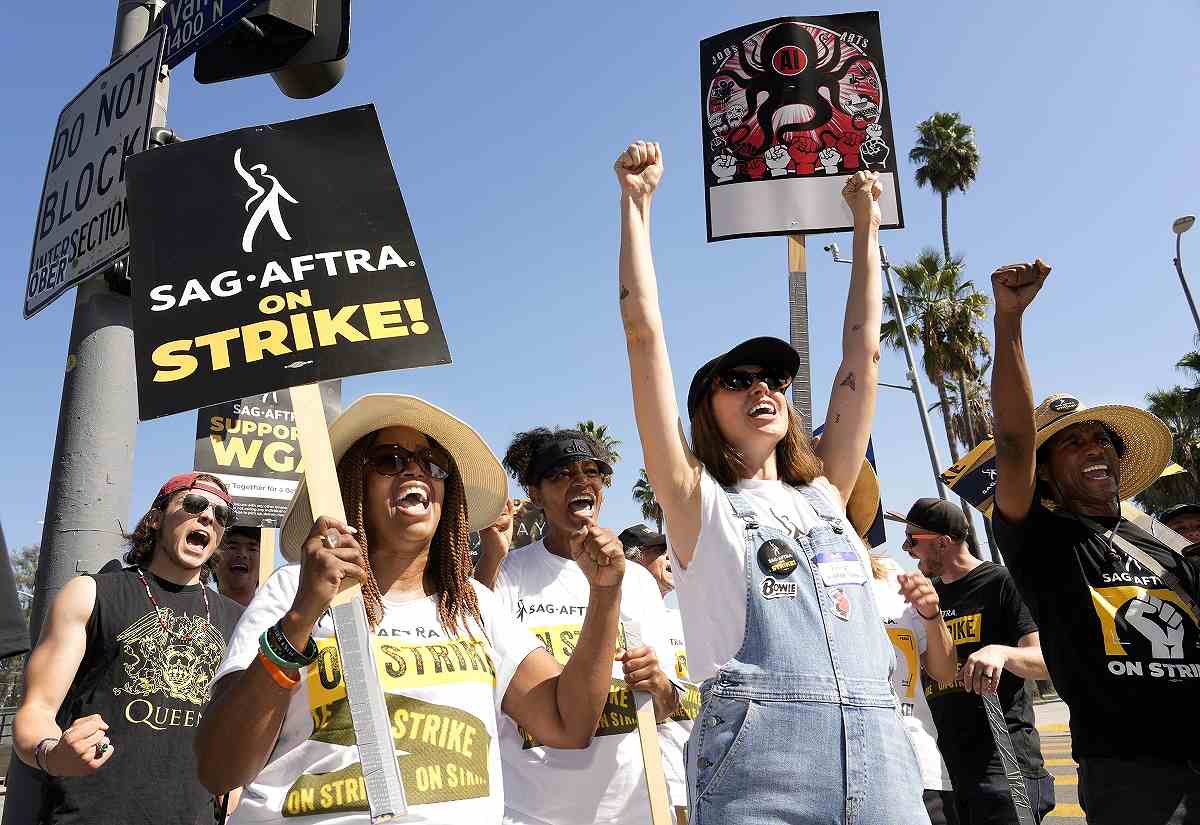Hollywood’s Actors Strike is Nearing Its 100th Day. Why Hasn’t a Deal been Reached and What’s Next?

Striking actors Jennifer Leigh Warren, left, and Emily Kincaid, right, demonstrate outside Netflix studios, Tuesday, Oct. 17, 2023, in Los Angeles.
11:37 JST, October 20, 2023
LOS ANGELES (AP) — While screenwriters are busy back at work, film and TV actors remain on picket lines, with the longest strike in their history set to hit 100 days on Saturday after talks broke off with studios. Here’s a look at where things stand, how their stretched-out standoff compares to past strikes, and what happens next.
INSIDE THE ACTORS-STUDIO TALKS THAT FAILED
Hopes were high and leaders of the Screen Actors Guild-American Federation of Television and Radio Artists were cautiously optimistic when they resumed negotiations on Oct. 2 for the first time since the strike began 2 1/2 months earlier.
The same group of chief executives from the biggest studios had made a major deal just over a week earlier with striking writers, whose leaders celebrated their gains on many issues actors are also fighting for: long-term pay, consistency of employment and control over the use of artificial intelligence.
But the actors’ talks were tepid, with days off between sessions and no reports of progress. Then studios abruptly ended them on Oct. 11, saying the actors’ demands were exorbitantly expensive and the two sides were too far apart to continue.
“We only met with them a couple of times, Monday, half a day Wednesday, half a day Friday. That was what they were available for,” SAG-AFTRA President Fran Drescher told The Associated Press soon after the talks broke off. “Then this past week, it was Monday and a half a day on Wednesday. And then “Bye bye. I’ve never really met people that actually don’t understand what negotiations mean. Why are you walking away from the table?”
The reasons, according to the Alliance of Motion Picture and Television Producers, included a union demand for a fee for each subscriber to streaming services.
“SAG-AFTRA gave the member companies an ultimatum: either agree to a proposal for a tax on subscribers as well as all other open items, or else the strike would continue,” the AMPTP said in a statement to the AP. “The member companies responded to SAG-AFTRA’s ultimatum that unfortunately, the tax on subscribers poses an untenable economic burden.”
Netflix co-CEO Ted Sarandos, one of the executives in on the bargaining sessions, told investors on an earnings call Wednesday that “This really broke our momentum unfortunately.”
SAG-AFTRA leaders said it was ridiculous to frame this demand as as though it were a tax on customers, and said it was the executives themselves who wanted to shift from a model based on a show’s popularity to one based on number of subscribers.
“We made big moves in their direction that have just been ignored and not responded to,” Duncan Crabtree-Ireland, SAG-AFTRA’s national executive director and chief negotiator, told the AP. “We made changes to our AI proposal. We made dramatic changes to what used to be our streaming revenue share proposal,” Crabtree-Ireland said.
The studios said just after the talks broke off that the per-subscriber charge would cost them $800 million annually, a figure SAG-AFTRA said was a vast overestimate.
The AMPTP later responded that the number was based on a union request for $1 per customer per year, which was lowered to 57 cents after SAG-AFTRA changed its evaluation to cut out non-relevant programming like news and sports.
WHAT HAPPENS NEXT IN THE ACTORS STRIKE?
The actors are in unscripted territory, with no end in sight. Their union has never been on a strike this long, nor been on strike at all since before many of its members were born. Not even its veteran leaders, like Crabtree-Ireland, with the union for 20 years, have found themselves in quite these circumstances.
As they did for months before the talks broke off, members and leaders will rally, picket and speak out publicly until the studios signal a willingness to talk again. No one knows how long that will take. SAG-AFTRA says it is willing to resume at any time, but that won’t change its demands.
“I think that they think that we’re going to cower,” Drescher said. “But that’s never going to happen because this is a crossroads and we must stay on course.”
The writers did have their own false start with studios that may give some reason for optimism. Their union attempted to restart negotiations with studios in mid-August, more than three months into their strike. Those talks went nowhere, breaking off after a few days. A month later, the studio alliance came calling again. Those talks took off, with most of their demands being met after five marathon days that resulted in a tentative deal that its members would vote to approve almost unanimously.
HOW DID PREVIOUS ACTORS STRIKES PLAY OUT?
Hollywood actors strikes have been less frequent and shorter than those by writers. The Screen Actors Guild (they added the “AFTRA” in a 2011 merger) has gone on strike against film and TV studios only three times in its history.
In each case, emerging technology fueled the dispute. In 1960 — the only previous time actors and writers struck simultaneously — the central issue was actors seeking pay for when their work in film was aired on television, compensation the industry calls residuals. The union, headed by future U.S. President Ronald Reagan, was a smaller and much less formal entity then. The vote to strike took place in the home of actors Tony Curtis and Janet Leigh, the parents of current SAG-AFTRA member and vocal striker Jamie Lee Curtis.
Mid-strike, the actors and studios called a truce so all could attend the Academy Awards — a move forbidden under today’s union rules. Host Bob Hope called the gathering “Hollywood’s most glamorous strike meeting.”
In the end, a compromise was reached where SAG dropped demands for residuals from past films in exchange for a donation to their pension fund, along with a formula for payment when future films aired on TV. Their 42-day work stoppage began and ended all within the span of the much longer writers strike.
A 1980 strike would be the actors’ longest for film and television until this year. That time, they were seeking payment for their work appearing on home video cassettes and cable TV, along with significant hikes in minimum compensation for roles. A tentative deal was reached with significant gains but major compromises in both areas. Union leadership declared the strike over after 67 days, but many members were unhappy and balked at returning to work. It was nearly a month before leaders could rally enough votes to ratify the deal.
This time, it was the Emmy Awards that fell in the middle of the strike. The Television Academy held a ceremony, but after a boycott was called, only one acting winner, Powers Boothe, was there to accept his trophy.
Other segments of the actors union have gone on strike too, including several long standoffs over the TV commercials contract. A 2016-2017 strike by the union’s video game voice actors lasted a whopping 11 months. That segment of the union could strike again soon if a new contract deal isn’t reached.
WHAT’S HAPPENING TO MOVIES AND TV SHOWS?
The return of writers has gotten the Hollywood production machine churning again, with rooms full of scribes penning new seasons of shows that had been suspended and film writers finishing scripts. But the finished product will await the end of actors strike, and production will remain suspended many TV shows and dozens of films, including “Wicked,” “Deadpool 3” and “Mission Impossible — Dead Reckoning Part 2.”
The Emmys, whose nominations were announced the same day the actors strike was called, opted to wait for the stars this time and move their ceremony from September to January, though that date could be threatened too.
The Oscars are a long way off in March, but the campaigns to win them are usually well underway by now. With some exceptions — non-studio productions approved by the union — performers are prohibited from promoting their films at press junkets or on red carpets. Director Martin Scorsese has been giving interviews about his new Oscar contender “ Killers of the Flower Moon.” Star and SAG-AFTRA member Leonardo DiCaprio hasn’t.
"News Services" POPULAR ARTICLE
-

American Playwright Jeremy O. Harris Arrested in Japan on Alleged Drug Smuggling
-

Japan’s Nikkei Stock Average as JGB Yields, Yen Rise on Rate-Hike Bets
-

Japan’s Nikkei Stock Average Licks Wounds after Selloff Sparked by BOJ Hike Bets (UPDATE 1)
-

Japan’s Nikkei Stock Average Buoyed by Stable Yen; SoftBank’s Slide Caps Gains (UPDATE 1)
-

Japanese Bond Yields Zoom, Stocks Slide as Rate Hike Looms
JN ACCESS RANKING
-

Keidanren Chairman Yoshinobu Tsutsui Visits Kashiwazaki-Kariwa Nuclear Power Plant; Inspects New Emergency Safety System
-

Imports of Rare Earths from China Facing Delays, May Be Caused by Deterioration of Japan-China Relations
-

Tokyo Economic Security Forum to Hold Inaugural Meeting Amid Tense Global Environment
-

University of Tokyo Professor Discusses Japanese Economic Security in Interview Ahead of Forum
-

Japan Pulls out of Vietnam Nuclear Project, Complicating Hanoi’s Power Plans


























